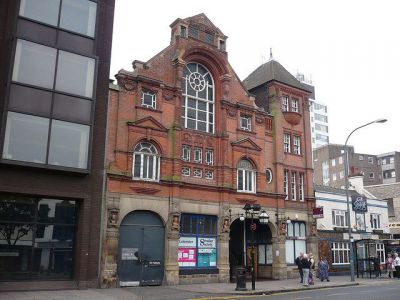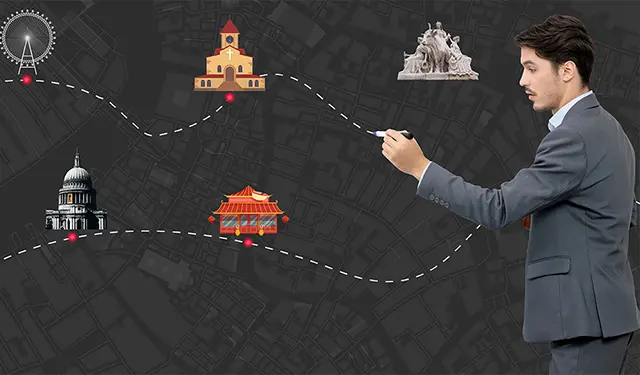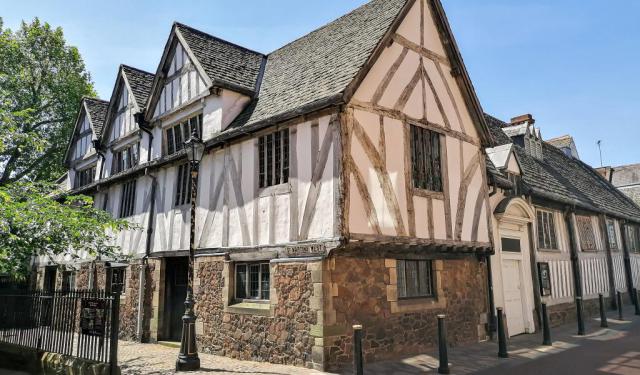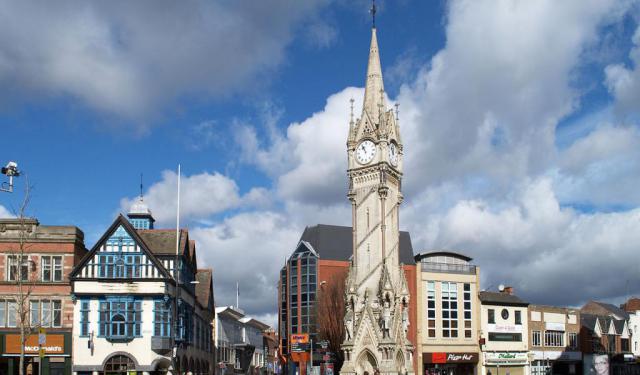
Secular Hall, Leicester
Secular Hall, a Grade II listed building, stands as a landmark of free thought and progressive ideals in the heart of Leicester. Built in 1881 for the city's Secular Society, the hall was commissioned by the Leicester Secular Hall Company, with engineer and councilor Josiah Gimson serving as the lead shareholder. Ownership later passed to the Leicester Rationalist Trust.
Designed by William Larner Sugden of Leek, Staffordshire, the hall reflects a 'Free Flemish Renaissance' architectural style, as noted in the Historic England listing. This choice was deliberate, aligning with the period's trend of employing non-Gothic styles such as Queen Anne to distinguish civic buildings from the Anglican Church. Sugden, a Secularist himself, had been influenced by William Morris, whose ideas he encountered while working with his father in Leek.
The striking façade of the Secular Hall features five busts in chronological order: Socrates, Jesus, Voltaire, Thomas Paine, and Robert Owen, symbolizing the evolution of rationalist and progressive thought. The hall's construction was reportedly inspired by George Holyoake’s 1871 articles proposing a network of Secular Halls across the country, an idea enthusiastically embraced by Leicester’s secularists. Although F.J. Gould suggested that the hall was a response to Holyoake being denied a public lecture space in 1872, historian Ned Newitt has disputed this claim, noting that secularists had been meeting in Leicester without restriction since 1868.
The hall was inaugurated on 6 March 1881, with speeches by Josiah Gimson, Charles Bradlaugh, and Annie Besant. Over the years, it has hosted a remarkable array of radical thinkers, including Edward Aveling, George Bernard Shaw, and William Morris. More than just an architectural landmark, Leicester Secular Hall remains a testament to the enduring values of free thought, debate, and social progress.
Designed by William Larner Sugden of Leek, Staffordshire, the hall reflects a 'Free Flemish Renaissance' architectural style, as noted in the Historic England listing. This choice was deliberate, aligning with the period's trend of employing non-Gothic styles such as Queen Anne to distinguish civic buildings from the Anglican Church. Sugden, a Secularist himself, had been influenced by William Morris, whose ideas he encountered while working with his father in Leek.
The striking façade of the Secular Hall features five busts in chronological order: Socrates, Jesus, Voltaire, Thomas Paine, and Robert Owen, symbolizing the evolution of rationalist and progressive thought. The hall's construction was reportedly inspired by George Holyoake’s 1871 articles proposing a network of Secular Halls across the country, an idea enthusiastically embraced by Leicester’s secularists. Although F.J. Gould suggested that the hall was a response to Holyoake being denied a public lecture space in 1872, historian Ned Newitt has disputed this claim, noting that secularists had been meeting in Leicester without restriction since 1868.
The hall was inaugurated on 6 March 1881, with speeches by Josiah Gimson, Charles Bradlaugh, and Annie Besant. Over the years, it has hosted a remarkable array of radical thinkers, including Edward Aveling, George Bernard Shaw, and William Morris. More than just an architectural landmark, Leicester Secular Hall remains a testament to the enduring values of free thought, debate, and social progress.
Want to visit this sight? Check out these Self-Guided Walking Tours in Leicester. Alternatively, you can download the mobile app "GPSmyCity: Walks in 1K+ Cities" from Apple App Store or Google Play Store. The app turns your mobile device to a personal tour guide and it works offline, so no data plan is needed when traveling abroad.
Secular Hall on Map
Sight Name: Secular Hall
Sight Location: Leicester, England (See walking tours in Leicester)
Sight Type: Attraction/Landmark
Guide(s) Containing This Sight:
Sight Location: Leicester, England (See walking tours in Leicester)
Sight Type: Attraction/Landmark
Guide(s) Containing This Sight:
Walking Tours in Leicester, England
Create Your Own Walk in Leicester
Creating your own self-guided walk in Leicester is easy and fun. Choose the city attractions that you want to see and a walk route map will be created just for you. You can even set your hotel as the start point of the walk.
Historical Buildings
Leicester, a city in England's East Midlands, has a storied past that is vividly presented in its historical buildings. Valuable architectural monuments, they are the city's pride and as such enjoy special protection by the government.
Among such, Magazine Gateway stands as a testament to the city's medieval legacy. Originally part of its defensive walls, this structure now... view more
Tour Duration: 2 Hour(s)
Travel Distance: 2.6 Km or 1.6 Miles
Among such, Magazine Gateway stands as a testament to the city's medieval legacy. Originally part of its defensive walls, this structure now... view more
Tour Duration: 2 Hour(s)
Travel Distance: 2.6 Km or 1.6 Miles
Leicester Introduction Walking Tour
Leicester is one of the oldest cities in England, whose history goes back almost two millennia. The Romans arrived in the area around 47 AD, during their conquest of southern Britain. Following the Saxon invasion, Leicester was then captured by Danish Vikings, in the 9th century.
The settlement was first documented in the early 10th century, under the name Ligeraceaster. At the time of the... view more
Tour Duration: 1 Hour(s)
Travel Distance: 1.1 Km or 0.7 Miles
The settlement was first documented in the early 10th century, under the name Ligeraceaster. At the time of the... view more
Tour Duration: 1 Hour(s)
Travel Distance: 1.1 Km or 0.7 Miles


